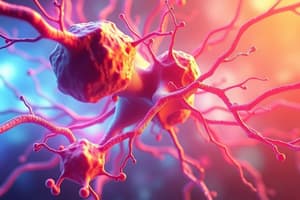Podcast
Questions and Answers
Which of the following responses is associated with the sympathetic nervous system?
Which of the following responses is associated with the sympathetic nervous system?
- Increased digestive activity
- Increased urinary function
- Decreased heart rate
- Increased ventilation (correct)
What is the primary role of the vagus nerve in the autonomic nervous system?
What is the primary role of the vagus nerve in the autonomic nervous system?
- Facilitating vision and eye movement
- Managing parasympathetic functions (correct)
- Controlling fight or flight responses
- Regulating skeletal muscle contractions
Which of the following is NOT a function of the parasympathetic nervous system?
Which of the following is NOT a function of the parasympathetic nervous system?
- Decreased heart rate
- Increased urinary function
- Increased digestive activity
- Increased blood pressure (correct)
Which type of receptor is involved in the sympathetic nervous system response?
Which type of receptor is involved in the sympathetic nervous system response?
What is the primary neurotransmitter released by preganglionic sympathetic neurons?
What is the primary neurotransmitter released by preganglionic sympathetic neurons?
Which ganglia are associated with the autonomic nervous system's responses to the eyes and nasal cavity?
Which ganglia are associated with the autonomic nervous system's responses to the eyes and nasal cavity?
Which of the following stimuli is associated with the sympathetic nervous system?
Which of the following stimuli is associated with the sympathetic nervous system?
What type of physiological processes does the autonomic nervous system primarily regulate?
What type of physiological processes does the autonomic nervous system primarily regulate?
Which of the following correctly describes the role of the adrenal medulla in the sympathetic nervous system?
Which of the following correctly describes the role of the adrenal medulla in the sympathetic nervous system?
What physiological function is increased as a result of parasympathetic activation?
What physiological function is increased as a result of parasympathetic activation?
Flashcards are hidden until you start studying
Study Notes
Autonomic Nervous System
- Controls involuntary physiological processes like digestion, heart rate, and blood pressure.
Afferent & Efferent Nerves
-
Afferent brings sensory information to the central nervous system.
- Somatic sensory nerves carry information from the skin, muscles, and joints.
- Visceral sensory nerves carry information from internal organs.
- Special sensory nerves carry information from the senses of smell, taste, sight, hearing, and balance.
-
Efferent nerves carry motor commands from the central nervous system to the body.
- Somatic nerves control voluntary muscle movement.
- Autonomic nerves control involuntary processes and are divided into sympathetic and parasympathetic branches.
Sympathetic Nervous System
- The "fight or flight" response triggered by stress, excitement, emergencies, or exercise.
- Increases heart rate, ventilation, blood pressure, local skeletal muscle blood flow.
- Decreases urinary and digestive activity.
- Increases sweat production.
- Promotes catabolism (breakdown of energy reserves).
- Includes the skin.
- Preganglionic neurons are located in the lateral horn of the spinal cord.
Sympathetic Ganglia
- Preganglionic fibers exit the spinal cord and synapse with postganglionic neurons in ganglia outside the nervous system:
- There are two thoracic and two lumbar ganglia.
- Three cervical ganglia (superior, middle, and inferior) lack direct spinal nerve connections and rely on the sympathetic trunk.
Parasympathetic Nervous System
- The "rest and digest" response, associated with relaxation, recovery, and repair.
- Decreases heart rate, ventilation, blood pressure.
- Increases vasodilation and blood flow to the digestive system.
- Increases urinary activity (kidney, bladder, gut).
- Promotes anabolism (building up energy sources and storing them in the liver).
Parasympathetic Ganglia
- Preganglionic fibers from the brainstem and sacral spinal cord synapse with postganglionic neurons in ganglia near target organs:
- Ciliary ganglion: Cranial nerve 3 (oculomotor) – controls eye muscles.
- Pterygopalatine ganglion: Cranial nerve 7 (facial) – controls tear, saliva, and mucus production.
- Submandibular ganglion: Cranial nerve 7 (facial) – controls saliva production.
- Otic ganglion: Cranial nerve 9 (glossopharyngeal) – controls salivary glands.
Enteric Nervous System
- A network of neurons within the walls of the digestive system.
- Controls digestion.
Types of Receptors
- Exteroceptors: Receive sensory information from outside the body:
- Somatic sensory receptors: Found in the muscle and skin for sensing touch, pressure, temperature, and pain.
- Autonomic receptors: Allow the nervous system to monitor and control internal organ functions.
- Enteroceptors: Receive visceral sensory information from within the body.
Cranial Nerve 10 (Vagus Nerve)
- Plays a major role in the parasympathetic nervous system, contributing about 75%.
- Contains motor fibers to the heart, and afferent fibers carrying sensory information (taste buds, blood pressure) and contributing to feelings of calmness.
Activation
-
Somatic nervous system:
- Stimulates skeletal muscles using acetylcholine.
- Uses nicotinic receptors (ionotropic, fast) at the neuromuscular junction.
-
Autonomic nervous system:
- Preganglionic neurons release acetylcholine.
- Postganglionic neurons release norepinephrine.
-
Sympathetic nervous system:
- Preganglionic neurons release acetylcholine, acting on nicotinic receptors at the ganglia.
- Sympathetic neurons directly contact the adrenal medulla, which releases epinephrine.
- Epinephrine increases liver function, fat breakdown, and vasodilation.
- See sympathetic response characteristics above.
-
Parasympathetic nervous system:
- Postganglionic neurons release acetylcholine, acting on muscarinic receptors (metabotropic, slower) at target organs.
- Can be excitatory or inhibitory.
Studying That Suits You
Use AI to generate personalized quizzes and flashcards to suit your learning preferences.




